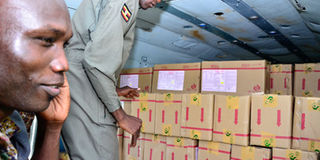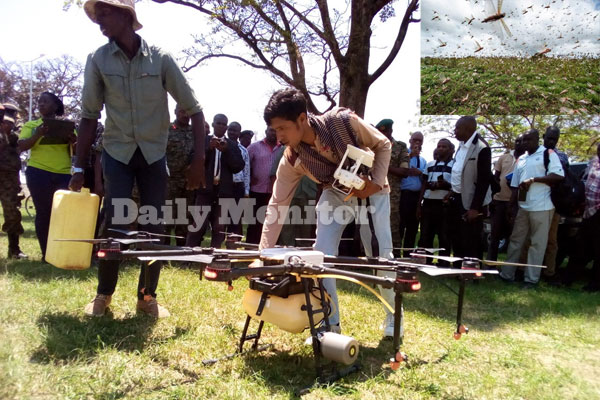Locust invasion: Government short of chemical spray

Control. The chemicals loaded on a helicopter at Kololo Independence Grounds on February 11, 2020. PHOTO BY ABUBAKER LUBOWA
The head of the inter-ministerial task force set up to fight locusts, Mr Stephen Byantwale, has said government is facing hardship in acquiring recommended chemicals for desert locust control due to limited supply on the market.
Mr Byantwale told Daily Monitor yesterday that the chemical shortage is caused by extreme demand from countries affected by desert locusts as the pests spread far and wide.
“There are challenges of finding those chemicals in the region because everyone is spraying,” he said.
Mr Byantwale, however, said government was searching for potential suppliers to acquire the chemical.
“We are contacting the regional agents to get the chemicals,” Mr Byantwale, also the ministry’s commissioner for crop protection, added.
The recommended chemical, Fenitrothion, according to regional locust control body Desert Locust Control Organisation of East Africa (DLCO-EA), is safer to environment, has least health effects on people and does not kill birds or wild animals exposed to it.
The chemical is being used in Kenya where the locusts attacked before entering Uganda.
Mr Evarist Magara, Uganda representative to Desert Locust Control Organisation of East Africa (DLCO-EA), said their organisation does not procure chemicals.
“Procuring chemical is left to governments of affected countries. We provide expert support and equipment for spraying,” Magara said.
Aircraft yet to arrive
According to insect experts at Makerere University, foot troops and vehicles as being employed by government are inefficient in managing locusts.
Asked whether they were considering use of aircraft, Mr Byantwale said government sent ministers to Kenya to source the aircraft.
“But appreciating that the best option for controlling desert locusts is aerial spraying, we are still finalising. By last night, honourable Musa Ecweru [State minister for Disaster Preparedness] and [Bright] Rwamirama [Minister of Animal Industry] were in Nairobi with two technical people to acquire aircraft from Kenya government,” Mr Byantwale said.
He said by yesterday evening the aircraft would have landed in Karamoja.
“We have been assured that by today afternoon, the aircraft shall be in Moroto,” he said.
However, when Daily Monitor contacted Mr Ecweru, he said he was on his way back to Uganda.
“Just leaving Nairobi right now for Kampala. I will let you know,” he said.
Previously, government said DLCO-EA would provide Uganda with aircraft to combat locusts if the country paid its subscription to the organisation.
However, even after government paid Shs11b in subscription to the locust control body, no aircraft was released to the country.
Mr Magara said the number of locusts in Uganda is too small to cause alarm for lack of aircraft.
“The situation on the ground does not warrant aircraft,” Mr Magara said.
Asked how severe the situation should be for aircraft to be released, he said: “ We are getting few small swarms of locusts and they are not even eating vegetation. In terms of control, it wouldn’t be economical to start spraying. You apply an aircraft when it is really big.”
Asked why government is looking for aircraft on their own after paying the subscription, he did not respond.
READ
Background
On Monday, government procured 36,000 litres of chemicals and 2,000 manual pumps that were airlifted to Moroto for locust spraying. The procured chemicals include cypermethrin and chlorpyrifos. The procured chemicals, according to the ministry are meant for ground spraying only and cannot be sprayed by aircraft.
[email protected]




